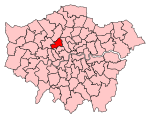West Hampstead railway station
DfT Category D stationsFormer London and North Western Railway stationsLondon stations without latest usage statistics 1415London stations without latest usage statistics 1516London stations without latest usage statistics 1617 ... and 5 more
Rail transport stations in London fare zone 2Railway stations in Great Britain opened in 1888Railway stations in the London Borough of CamdenRailway stations served by London OvergroundUse British English from August 2012

West Hampstead railway station is a London Overground station on the North London Line between Brondesbury and Finchley Road & Frognal in the London Borough of Camden and is in Travelcard Zone 2. The station and all trains are operated by London Overground.
Excerpt from the Wikipedia article West Hampstead railway station (License: CC BY-SA 3.0, Authors, Images).West Hampstead railway station
Heritage Lane, London West Hampstead (London Borough of Camden)
Geographical coordinates (GPS) Address External links Nearby Places Show on map
Geographical coordinates (GPS)
| Latitude | Longitude |
|---|---|
| N 51.5473 ° | E -0.1918 ° |
Address
West Hampstead
Heritage Lane
NW6 2AZ London, West Hampstead (London Borough of Camden, West Hampstead Square)
England, United Kingdom
Open on Google Maps









